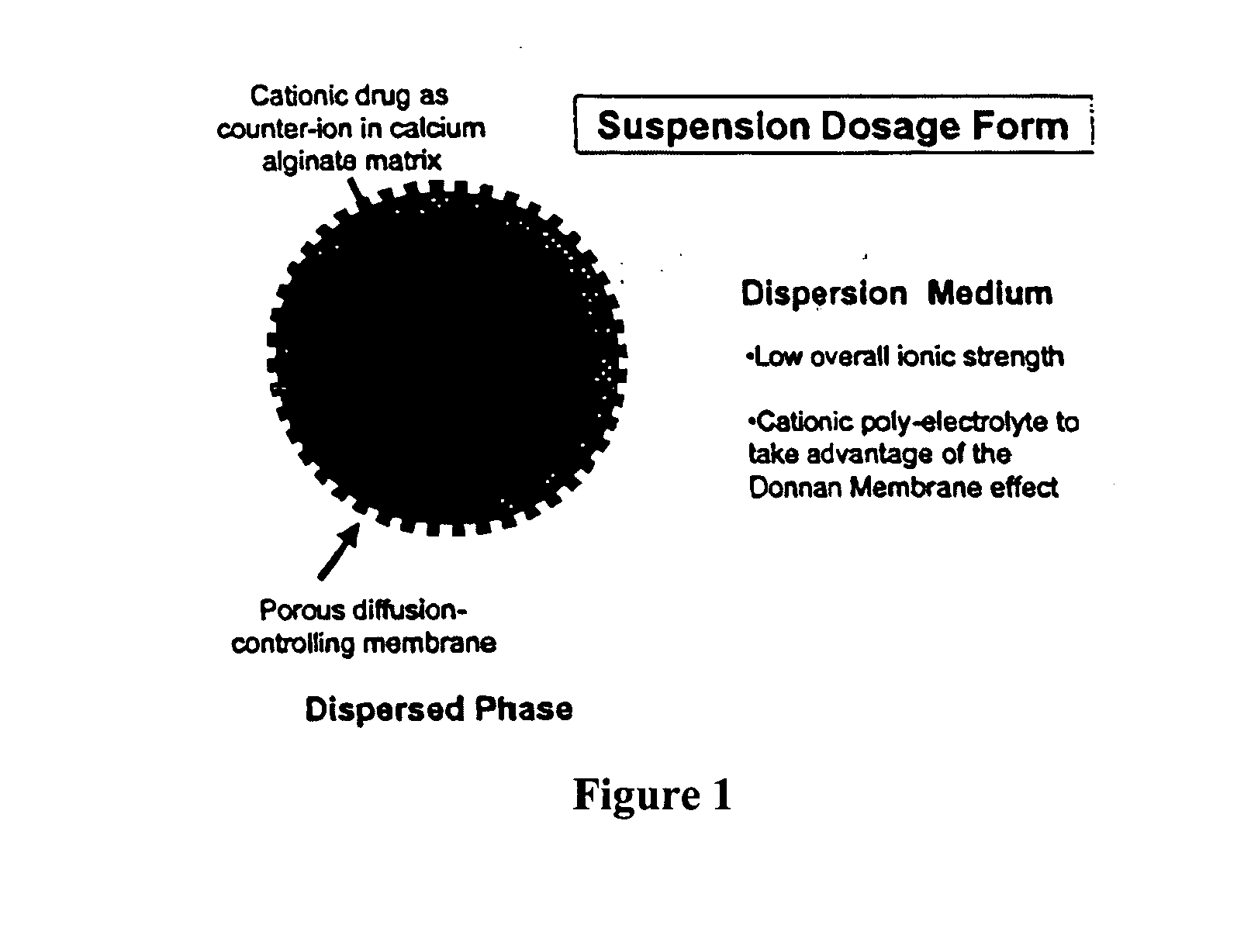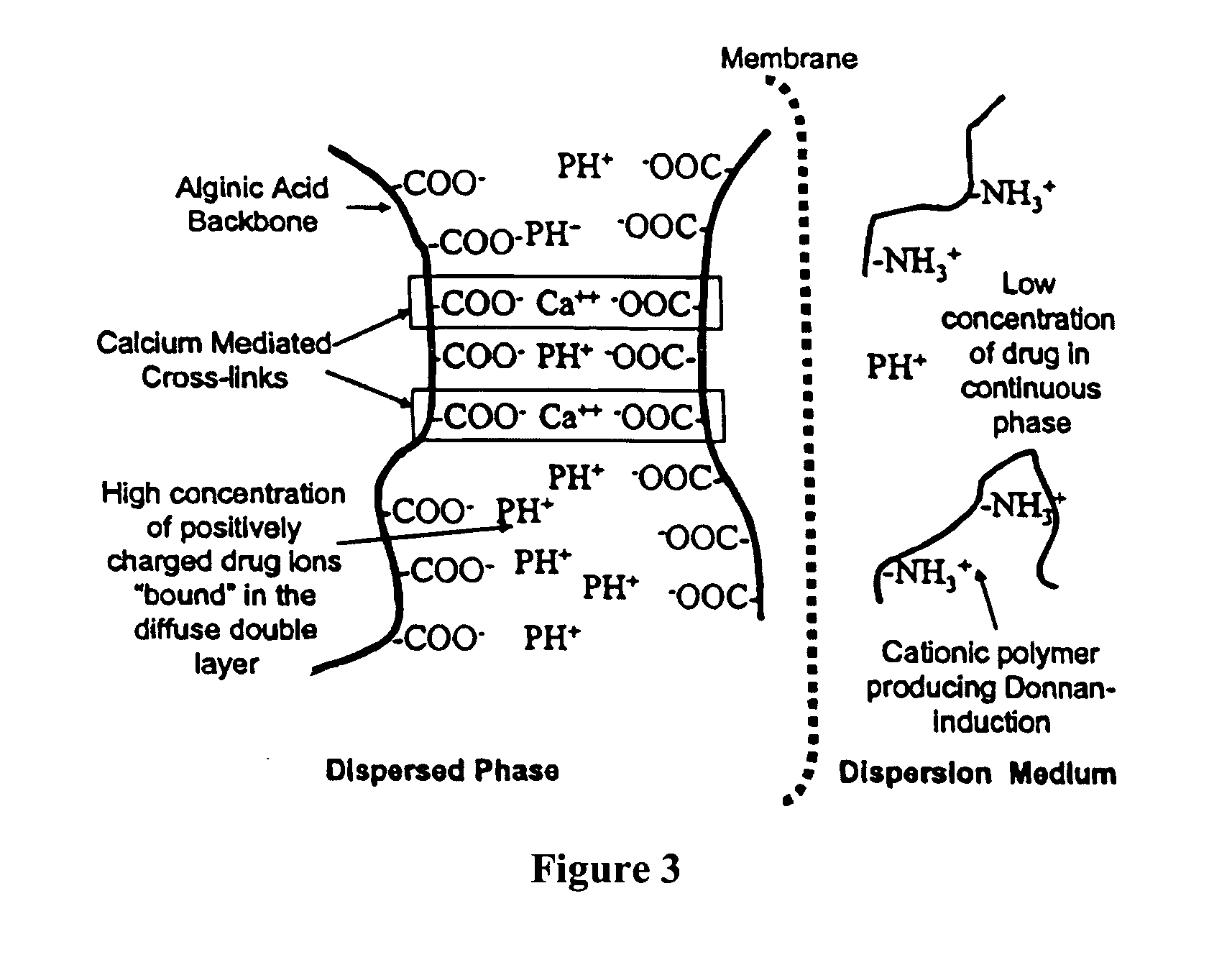Aqueous sustained-release drug delivery system for highly water-soluble electrolytic drugs
a drug delivery system and electrolytic drug technology, applied in the direction of drug compositions, dispersed delivery, synthetic polymeric active ingredients, etc., can solve the problems of limited success, limited success, and the release rate of adsorbed drugs cannot be controlled, and achieve the effect of altering the permeability of the coating
- Summary
- Abstract
- Description
- Claims
- Application Information
AI Technical Summary
Benefits of technology
Problems solved by technology
Method used
Image
Examples
example 1
6.1 Example 1
[0205] Example 1 describes a method for making a calcium alginate propranolol hydrochloride ion-exchange matrix drug complex.
[0206] A 2% dispersion of sodium alginate in deionized water was prepared and 500 mL was added via a fluid-metering pump at a rate of approximately 1 mL / min pumped through a 21 gauge needle to 1000 mL of a stirred solution containing 2% of calcium chloride in deionized distilled water at 25° C. as depicted in FIG. 6. The resultant mixture was stirred for about one additional hour at about 25° C. The mixture was filtered and beads washed with 3×1750 mL volumes of distilled water to remove excess calcium chloride. The resulting beads have structure because of the cross-linking, and the negative carboxyl groups that are not involved in cross links are neutralized by sodium and / or calcium counterions present in the diffuse double layer.
[0207] The dried beads from above were immersed in 2000 mL of 2.5% W / V propranolol hydrochloride solution and stirr...
example 2
6.2 Example 2
[0208] Example 2 describes the results of equilibrium binding studies involving the exemplary electrolytic drug propranolol hydrochloride and exemplary ion-exchange matrix including sodium alginate, xanthan gum, and gellan gum.
[0209] The studies were performed with a two compartment plexiglass dialysis cell (Hollenbeck laboratory) and having a cellulose membrane (molecular weight cutoff of 6000 Daltons) Bel-Art Products (Pequannock, N.J.) placed between the two cell compartments. For the sodium alginate studies, one compartment (“the drug compartment”) was charged with 15 mL of a {fraction (0 / 97)}×10−2 molar solution of propranolol hydrochloride in deionized water, while the other compartment (“the polymer compartment”) was charged with 15 mL of a 0.0877% W / V solution of the sodium alginate in deionized distilled water. The dialysis cell was shaken at 80 RPM in a thermostatic water bath at 25° C. until equilibrium was reached (30 h). The solution was removed from the d...
example 3
6.3 Example 3
[0216] Coating the Ion-Exchange Matrix Drug Complexes
[0217] Coating of the ion-exchange matrix drug complexes was performed using the fluid bed coater depicted in FIG. 8, which is useful for processing solids in the 5 to 30 g range. Typically, about 8 g of ion-exchange matrix drug complex was charged to the fluid bed coater. The inlet temperature was set to about 40° C. and the bed temperature was set to about 30° C. An aqueous dispersion containing Eudragit®RS 30 D (8.34 g) and triethly citrate (1.67) was prepared, and the dispersion was applied at a spray rate of 0.97 ml / min and at an atomization air pressure of about 30 psig. After application was completed, the coated particles were allowed to dry under flowing air in the fluid bed coater. The dried coated particles typically contained about 20-30% by weight of coating based on the total weight of applied coating and ion-exchange matrix drug complex.
PUM
| Property | Measurement | Unit |
|---|---|---|
| Substance count | aaaaa | aaaaa |
| Volume | aaaaa | aaaaa |
| Volume | aaaaa | aaaaa |
Abstract
Description
Claims
Application Information
 Login to View More
Login to View More - R&D
- Intellectual Property
- Life Sciences
- Materials
- Tech Scout
- Unparalleled Data Quality
- Higher Quality Content
- 60% Fewer Hallucinations
Browse by: Latest US Patents, China's latest patents, Technical Efficacy Thesaurus, Application Domain, Technology Topic, Popular Technical Reports.
© 2025 PatSnap. All rights reserved.Legal|Privacy policy|Modern Slavery Act Transparency Statement|Sitemap|About US| Contact US: help@patsnap.com



